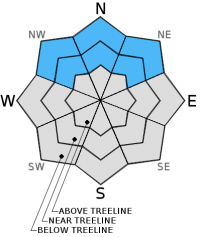| Saturday | Saturday Night | Sunday | |
|---|---|---|---|
| Weather: | Sunny skies. | Clear skies. | Sunny skies. |
| Temperatures: | 40 to 47 deg. F. | 25 to 35 deg. F. | 40 to 47 deg. F. |
| Mid Slope Winds: | North shifting to East in the afternoon. | East | Variable |
| Wind Speed: | 5 to 15 mph. | 5 to 15 mph. | Light winds |
| Expected snowfall: | 0 | 0 | 0 |
| Saturday | Saturday Night | Sunday | |
|---|---|---|---|
| Weather: | Sunny skies. | Clear skies. | Sunny skies. |
| Temperatures: | 35 to 45 deg. F. | 26 to 36 deg. F. | 40 to 47 deg. F. |
| Ridge Top Winds: | Northwest shifting to East in the afternoon. | East | Variable |
| Wind Speed: | 10 to 20 mph. Gusts up to 35 mph. | 10 to 15 mph. Gusts up to 25 mph. | Light winds |
| Expected snowfall: | 0 | 0 | 0 |

























